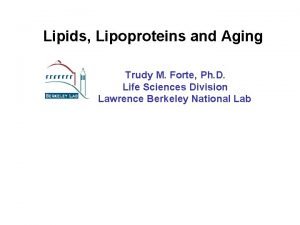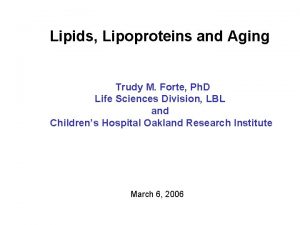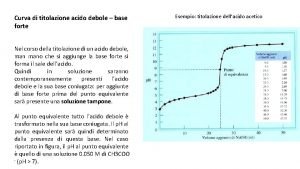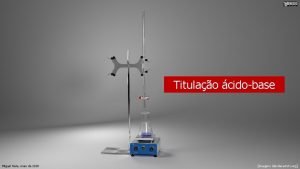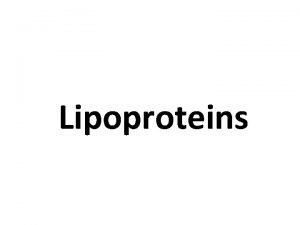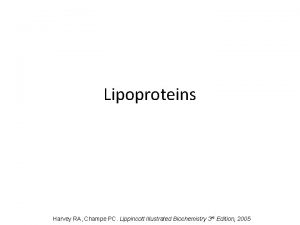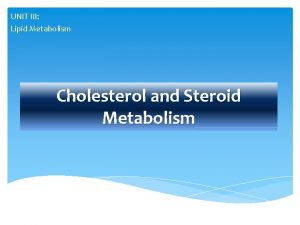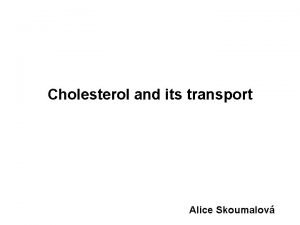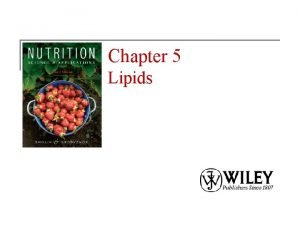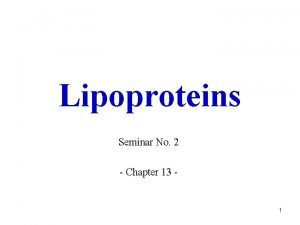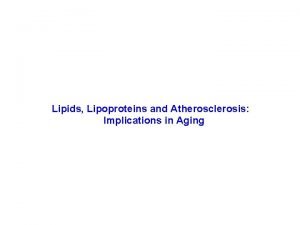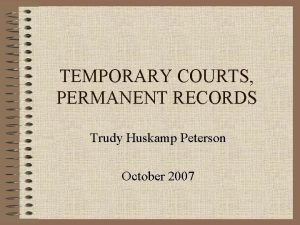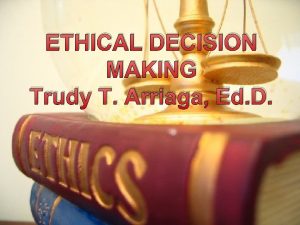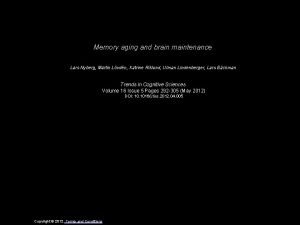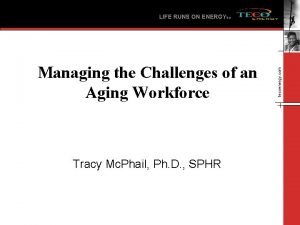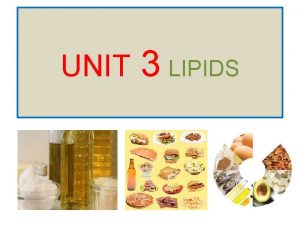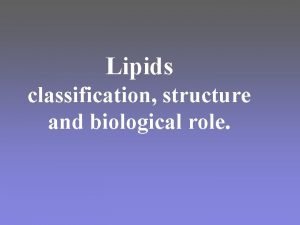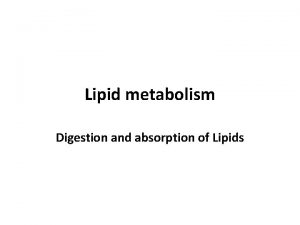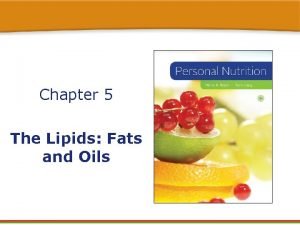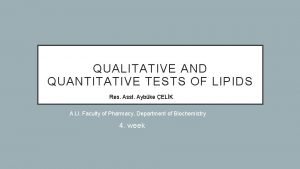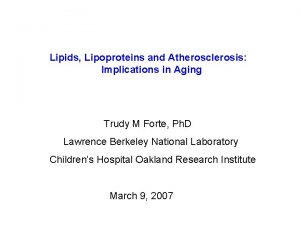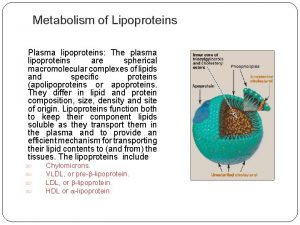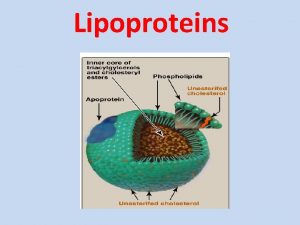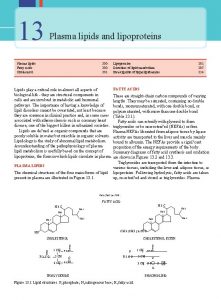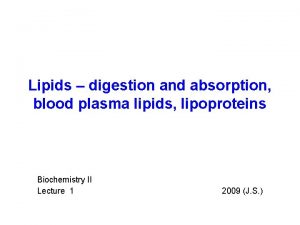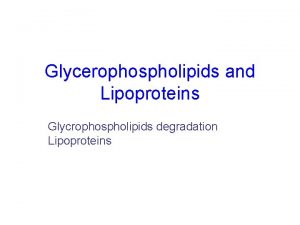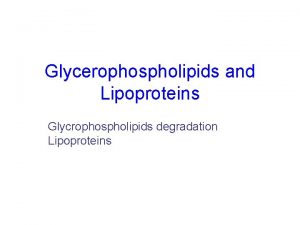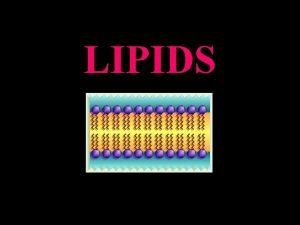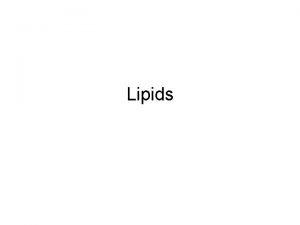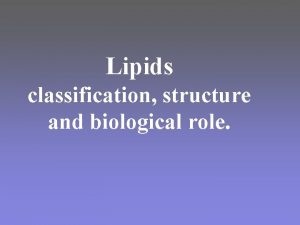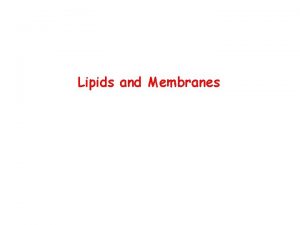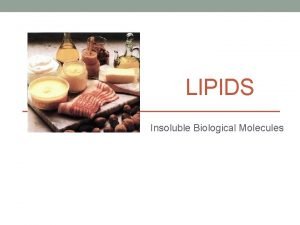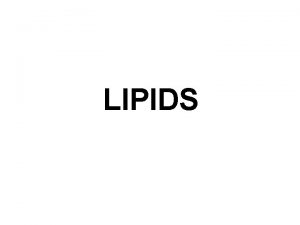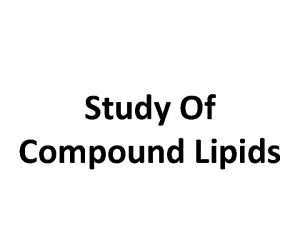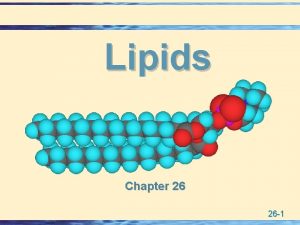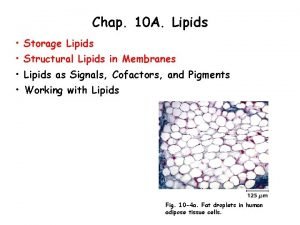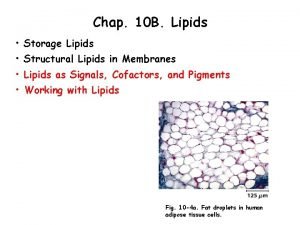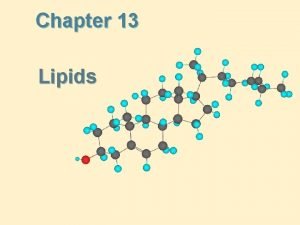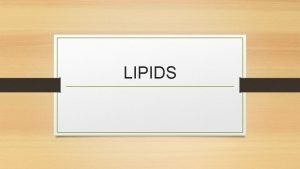Lipids Lipoproteins and Aging Trudy M Forte Ph


























- Slides: 26

Lipids, Lipoproteins and Aging Trudy M. Forte, Ph. D. Life Sciences Division Lawrence Berkeley National Lab

Early and late atherosclerotic lesions Fatty streak Thrombotic athero lesion, myocardial infarct

Generic Lipoprotein

Role of Lipids (Lipoproteins) in Metabolism Triglycerides Major energy source for cells Cholesterol Cell growth, cell division, membrane repair, steroid hormone production Lipids Transport of fat soluble vitamins

Normal Plasma Lipid Levels (mg/dl) Triglyceride Total Chol. HDL-Chol TC/HDLC Adult female 80 190 55 3. 5 Adult male 120 200 43 4. 7 Neonate 35 70 35 2. 0

Positive and Negative risk Factors in Atherosclerosis Positive Negative Age: Males > 45 years Elevated HDL cholesterol Females > 55 years Low LDL cholesterol Family history of early CHD Good genes Elevated LDL cholesterol (>130 mg/dl) Female gender (estrogen) Diabetes mellitus Excerise Hypertension Obesity Smoking CHD, coronary heart disease

Lipoprotein Nomenclature and Composition CM VLDL IDL LDL Major Protein apo. B apo. A-I Major Lipid TG TG CE CE CE CM= chylomicron VLDL= very low density lipoprotein IDL= intermediate density lipoprotein LDL= low density lipoprotein HDL= high density lipoprotein Apo = apolipoprotein HDL TG=triglyceride CE= cholesteryl ester

Site of Synthesis of Lipoproteins Liver Intestine apo. Cs VLDL apo. Cs CM apo. A-I Nascent-HDL apo. E apo. B-100 apo. E apo. B-48 IDL apo. B-100 LDL

Major Apolipoproteins and Their Function Apo Lipo Origin Function Apo. A-I HDL Liver, intestine Activate LCAT, Cholesterol efflux via ABCA 1 transporter Apo. B-100 VLDL, LDL Liver, intestine Ligand LDL receptor, TG transport from cells Apo(a) Lp(a) Apo. CII HDL, VLDL Apo. E VLDL, IDL Liver, intestine LCAT: lecithin: cholesterol acyltransferase ABCA 1: ATP binding cassette protein A 1 LRP: LDL receptor related protein Inhibits thrombolysis Activates lipoprotein lipase Ligand, LDL receptor, LRP receptor

Structure of Lp(a) apo. B-100 C LDL apo(a) N 4 C 4 4 N 5 S S 4 Kringle

Apo E Isoforms Apo E 3 most common, normal isoform a. a. 112 cys a. a. 158 arg Apo E 2 hypercholesteremia, inadequate clearance of remnants a. a. 112 cys a. a. 158 cys Apo E 4 elevated triglyceride; Alzheimers disease a. a. 112 arg a. a. 158 arg

Alzheimer’s disease and Lipoproteins Early onset AD, prior to age 60: • mutation in amyloid precursor protein gene, chr 21 • unidentified gene, chr 14 Late onset AD involves chr 19: • apo E gene on chr 19 • association of AD with apo E 4 allele • 80% of familial AD have at least one apo E 4 allele • apo E 4 a major risk factor in AD

Key Enzymes in Lipoprotein Metabolism • Lipoprotein lipase (LPL): hydrolysis of triglyceride rich particles • Lecithin: cholesterol acyltransferase (LCAT): participates in removal of excess cholesterol from peripheral cells

Lipoprotein Lipase (LPL) Endothelial Cell LPL apo. A-I apo. C-II Fatty Acids and Glycerol cholesterol TG CM Excess Surface Material VLDL apo. E Lipolytic products phospholipid CM Energy apo. E VLDL “Remnant” muscle TG = triglyceride HDL assembly Liver Bile acids

Lecithin: Cholesterol Acyl Transferase (LCAT) LCAT: Disk to sphere transformation Free cholesterol Cholesteryl ester Mature HDL Nascent HDL apo. A-I Phospholipid plus cholesterol LCAT CE Cholesteryl ester (CE) Cholesterol Phospholipid Apo. A-I Cholesteryl ester (CE) plus lysophospholipid

Key Receptors in Lipoprotein Metabolism • LDL receptor: catabolism of LDL, apo. B ligand • ABCA 1 transporter: transports excess cholesterol from cells, apo. A-I ligand • Scavenger receptor A 1 (SR-A 1): uptake of oxidized and modified LDL by macrophages • SR-B 1 receptor: selective uptake of excess cholesterol from HDL, apo. A-I ligand

LDL Receptor (apo. B-E receptor) Regulates cholesterol synthesis and plasma cholesterol levels HMG-Co. A reductase LDL-Receptors LDL Receptors ACAT Cholesterol LDL Endosome Cholesteryl ester (storage) Lysosome Amino acids

ABCA 1 Transporter/Receptor Large plasma membrane spanning ATP dependent protein. Essential for moving excess intracellular cholesterol and phospholipid to the plasma membrane. Acts as a flipase, flipping cholesterol and phospholipid from inner leaflet of plasma membrane to outer leaflet. Necessary for removing excess cholesterol from foam cells and preventing early steps in atherosclerosis. Apo. A-I is required for capturing the cholesterol released from the foam cell.

ABCA 1 Function Nascent HDL apo. A-I

Reverse Cholesterol Transport (RCT) The process whereby excess cholesterol in peripheral cells, especially foam cells, is returned to the liver for degradation and excretion. RCT involves apo. A-I, ABCA 1 and LCAT as well as receptors on the liver for uptake of the excess cholesterol.

Reverse Cholesterol Transport Delivery of peripheral tissue cholesterol to the liver for catabolism Requires HDL, apo. A-I and LCAT Peripheral Cell UC diffusion HDL UC HDL Macrophage/ Foam cell ABCA 1 UC PL LCAT Nascent HDL apo. A-I UC = unesterified cholesterol CE = esterified cholesterol PL = phospholipid LDLr = LDL receptor HDL CE CE CE SR-B 1 TG VLDL or LDL apo. B Bile to gut CE LDLr Liver

The Scavenger Receptor (SR-A 1 receptor) How macrophages deal with oxidized or modified LDL The scavenger receptor recognizes modified and/or oxidized LDL and internalizes the modified LDL. Accumulation of these modified LDL in the cell leads to the accumulation of cholesterol droplets in the macrophage and the formation of foam cells.

Modification of LDL Apo B-100 Derivatization: Aldehydes Glucosylation eg. diabetes Derivatized LDL Oxidation: Degradation of B-100 by reactive oxygen species Oxidized LDL

The Scavenger Receptor: Clearance of modified LDL by macrophages Macrophage Foam Cell Oxidized LDL Scavenger receptor (SR-A 1) Fatty streaks Lipid droplets

LDL and Atherosclerosis Fitting the pieces together Elevated LDL: Increased residence time in plasma Increased modification/oxidation of LDL Monocyte Cyt o Endothelial cells kin e Artery wall s ox. LDL (stimulates cytokine secretion) Cy Macrophage foam cell tok ine s Smooth muscle cell proliferation

HDL Protective Role Fitting the pieces together HDL Monocyte Endothelial cells ox. LDL HDL Artery wall UC HDL + UC apo. A-I ABCA 1 PL UC Macrophage foam cell Nascent HDL ox. LDL = oxidized LDL UC = unesterified cholesterol
 Trudy forte
Trudy forte Trudy forte
Trudy forte Curva titolazione acido debole base forte
Curva titolazione acido debole base forte Titulao
Titulao O fogo disse: eu sou mais forte
O fogo disse: eu sou mais forte Function of lipoprotein
Function of lipoprotein Lipoproteins
Lipoproteins Lipoproteins
Lipoproteins Structure of cholesterol
Structure of cholesterol Lipoproteins
Lipoproteins Lipoproteins
Lipoproteins Functions of lipoproteins
Functions of lipoproteins Trudy huskamp peterson
Trudy huskamp peterson Trudy arriaga
Trudy arriaga Different market forms of meat
Different market forms of meat Judy williams jessie emily schofield lyrics
Judy williams jessie emily schofield lyrics Uky disability resource center
Uky disability resource center Dane county aging and disability resource center
Dane county aging and disability resource center Trends in cognitive sciences
Trends in cognitive sciences Managing the aging workforce challenges and solutions
Managing the aging workforce challenges and solutions Office of aging and adults services
Office of aging and adults services Oaas as a service
Oaas as a service Fats and lipids
Fats and lipids Function of lipids
Function of lipids Are lipids digested in the stomach
Are lipids digested in the stomach Lipids vs fats
Lipids vs fats Qualitative tests for lipids
Qualitative tests for lipids
